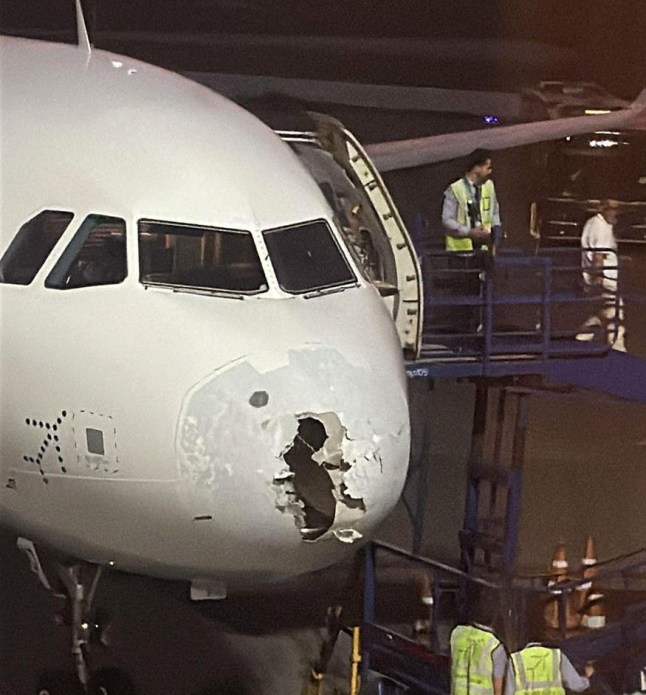
The nose of the Airbus A321 was damaged following a suspected bird hit (Picture: SWNS)
A flight carrying 227 passengers was forced to declare a mid-air emergency after its nose cone was torn apart.
Halfway into the IndiGo journey from Indira Gandhi International Airport in Delhi to Srinagar the Airbus A321 was battered by a violent hailstorm.
What began as a routine flight quickly turned into a nightmare as the plane then began rattling by severe turbulence.
It was at this point that a flock of bird struck the jet,leaving a large hole in the nose and endangering those on board.
Pilots reported the emergency to air traffic control at Srinagar,making a narrow escape.
Owais Maqbool,who claimed to be one the passengers,described the flight as a ‘near death experience’,adding that it was a ‘miracle’ that the plane managed to land.

The aircraft is currently being inspected with a huge hole in the nose cone (Picture: SWNS)
He wrote on X: ‘I was in the plane and heading back home from Srinagar… It was near death experience… the nose of the plane is damaged.
‘There was panic and people were screaming. Everyone was scared.’
Footage shared online shows the horror inside the cabin as passengers prey for survival while the plane shakes.
The crew of the Airbus A321 is now being applauded after the flight did not end in tragedy.
A statement from the airline,cited by Times of India,said: ‘IndiGo flight 6E 2142 operating from Delhi to Srinagar encountered sudden hailstorm en route.
‘The flight and cabin crew followed established protocol and the aircraft landed safely in Srinagar.
‘The airport team attended to the customers after arrival of the aircraft,prioritizing their wellbeing and comfort. The aircraft will be released post necessary inspection and maintenance.’
Bird strikes are common in the UK – in 2022,there were more than 1,400 incidents reported.
Most did not cause severe damage,but they can lead to engine fire and emergency landings.
Engines could stall or shut down if birds are sucked into them,but pilots typically have time to account for this and make an emergency landing.
An early theory in the December’s plane crash in South Korean,in which 179 people were killed,was that it was caused by birds.
Feathers were discovered in the engine of the aircraft,which crashed on the runway At Muan International Airport before bursting in flames.
Since then,the South Korean government ordered all its airports to install bird detection cameras and radars in response to the country’s worst-ever aviation disaster.
United News - unews.co.za